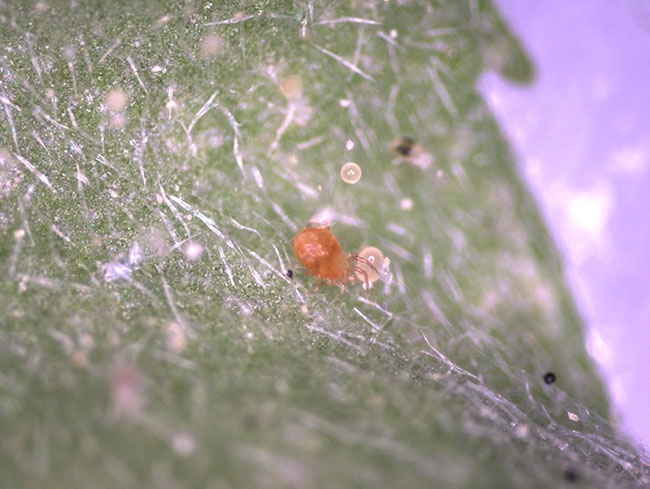
Features
Crop Protection
Inputs
Out With The Old In With the New?
Based on research from the “Integrated Control in Protected Crops” Working Group, it appears you can keep the old and add the new. Much of the focus at this year’s meeting was on “tweaking” existing programs to improve efficacy and stability.
April 15, 2015 By Sarah Jandricic
 Researchers are studying predators of spider mites and other pests to see how fluctuations in temperature and humidity affect their performance Photo courtesy OMAFRA
Researchers are studying predators of spider mites and other pests to see how fluctuations in temperature and humidity affect their performance Photo courtesy OMAFRAHaving recently changed jobs and cities, I’ve been thinking a lot about dealing with “newness.” Specifically, how do you keep the old parts of your life that you cherish (friendships, projects) going, while still keeping yourself open for new opportunities?
The same challenges exist in biological control. If your biocontrol program is generally working, why mess with it? But, keeping your program static may mean missing out on better or more cost-effective strategies.
Based on current research from the “Integrated Control in Protected Crops” Working Group – over 130 researchers dedicated to improving greenhouse Integrated Pest Management (IPM) – it appears you can keep the old and add the new. Much of the focus at this year’s meeting was on “tweaking” existing programs to improve efficacy and stability.
Picking the best biocontrol agent for your “climate.” A big research trend lately is how greenhouse temperature and humidity fluctuations affect biocontrol. This information can help explain control failures, or aid in selecting the best predators for your growing conditions.
For example, researchers found that P. persimilis, of all the spider mite predators, is most negatively affected by temperature fluctuations. Its predation rate is reduced 30 per cent under fluctuating conditions (15 C night; 30 C day) compared to a constant 25 C. Researchers think Neoseiulus fallacis may give more consistent control in greenhouses with particularly variable conditions, since it’s less affected by temperature swings. Research is continuing in commercial greenhouses.
Biocontrol companies are now also looking at changing sachet formulations to perform better under winter conditions, since breeding sachets for Amblyseius swirskii and N. cucumeris release fewer mites at lower humidity. Placing sachets well within the plant canopy can help. But one day we may be treating our sachets like our wardrobes, switching out “summer” and “winter” products as seasons change.
Combining bios gives better control. Combining different types of agents to boost control was also a major meeting theme. Some of the best research on this was done here
at Vineland.
Dr. Michael Brownbridge’s lab demonstrated that weekly “sprenches” of nematodes, along with Metarhizium pre-mixed into the growing medium (at 500g/m3), gave better thrips control than either treatment alone. In fact, control was 50 per cent better, all while remaining compatible with mite sachets.
Feeding your Friends. Another popular topic was supplemental food for predators, to promote their presence and reproduction on the crop.
A novel idea for thrips predators is to mix food mites with mulch and add this to the surface of the pot. This improves predator numbers and thrips control, without affecting A. swirskii or N. cucumeris distribution on plants – a real concern when moving supplemental food to the soil. This “mite mulch” also has the added benefit of increasing rove beetle numbers. How this compares to mite pollen feeding remains to be seen, but it could be an interesting alternative.
The addition of flour mites can also improve mealybug control by the lacewing Chrysoperla carnea. But a “better” food source (Ephestia moth eggs) just distracted the lacewings, showing us that you can have too much of a good thing when it comes to supplemental feeding.
New technologies improve knowledge. More information – whether it be from researchers’ new genetic tests for pest “biotypes” or better ways of sharing data – can only lead to better solutions in time.
With this in mind, I encourage you to check out the new Ontario Floriculture IPM blog, now live at ONfloriculture.wordpress.com. ONFloriculture will serve as a bite-sized supplement to the more in-depth articles published here, covering breaking news on IPM strategies, registrations and emerging pests. Visit regularly, or subscribe to have articles automatically sent to your email account.
Sarah Jandricic (JAN-DRIS-SICK) is the greenhouse floriculture IPM specialist for OMAFRA. She is responsible for IPM for insects and plant diseases. She can be reached at sarah.jandricic@ontario.ca, or 905-562-4141 ext. 106.
Print this page